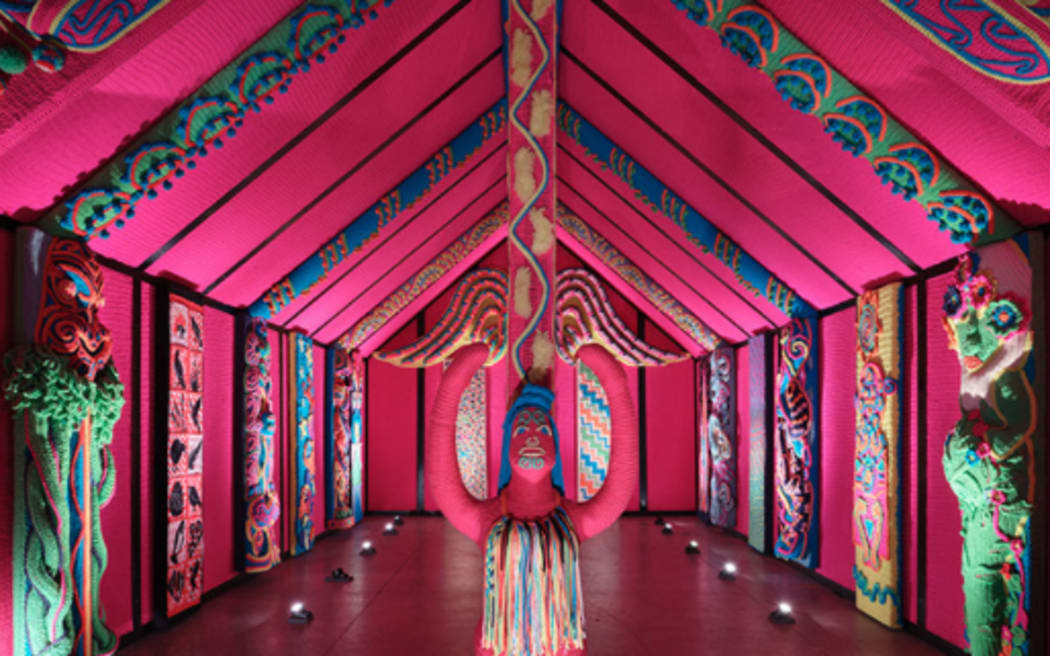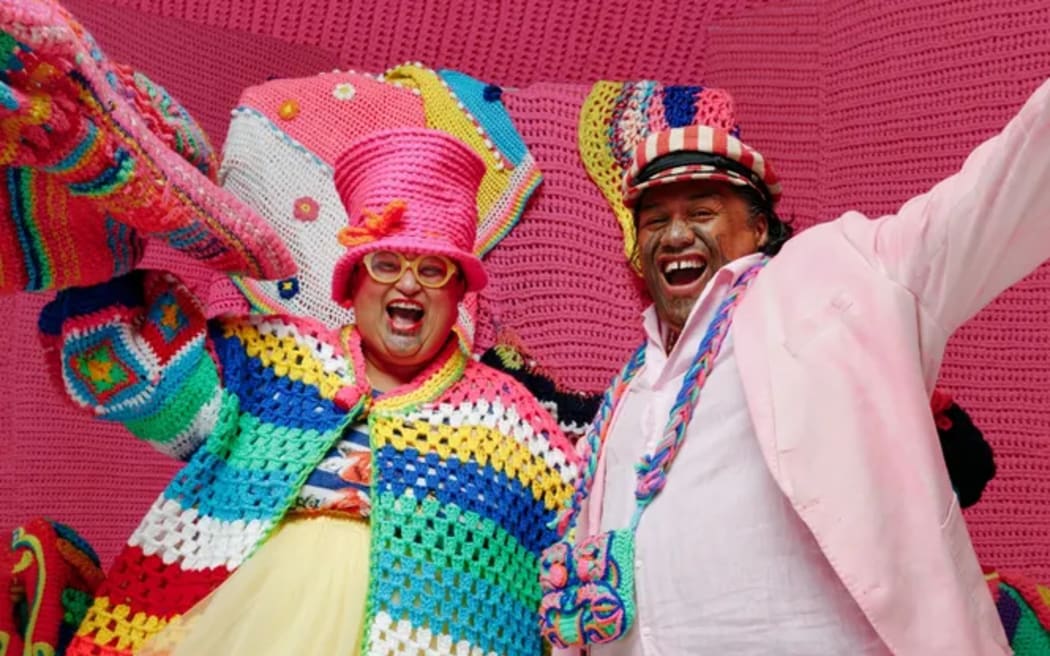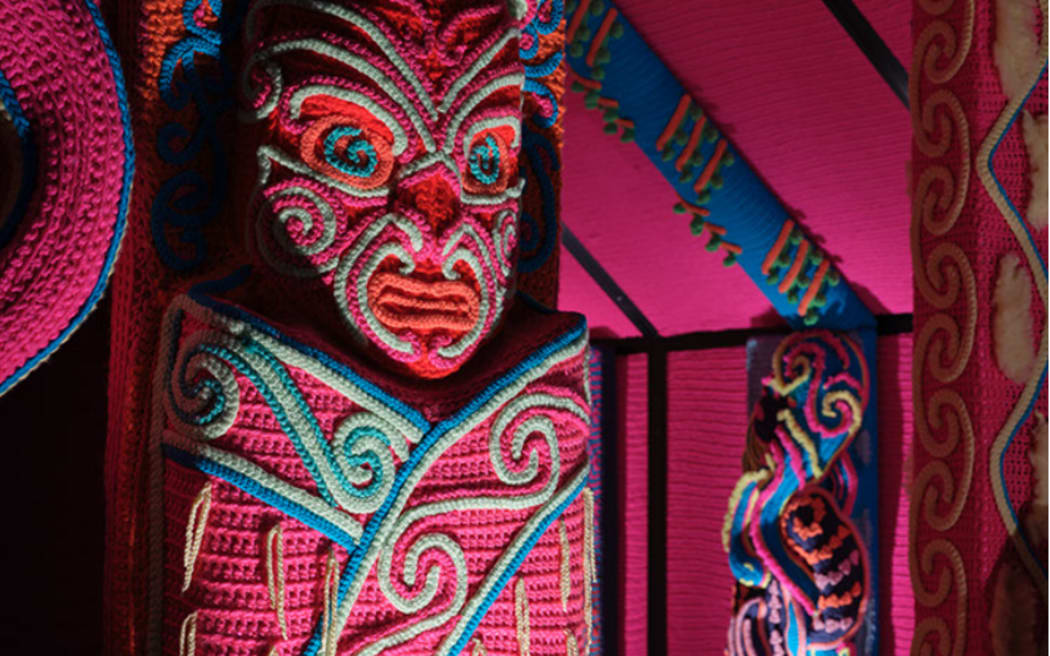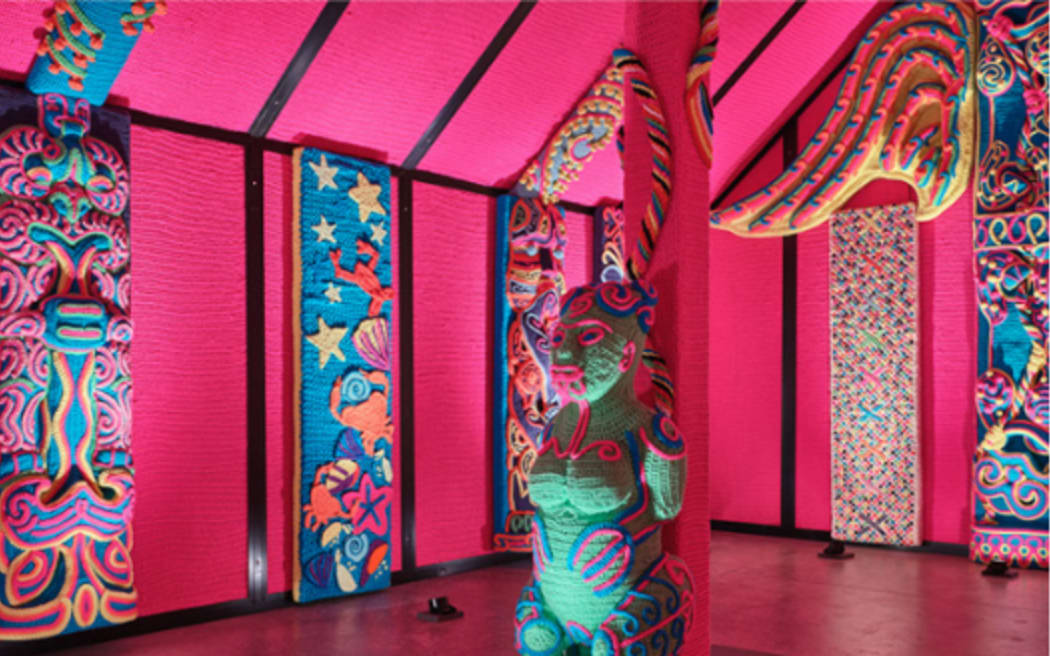
Wharenui Harikoa by Lissy Robinson-Cole and Rudi Robinson. Photo: Supplied
Five thousand balls of wool and a "kaupapa of joy" have been woven together to create what might be the most heartwarming building in Aotearoa.
Next week, artists Lissy Robinson-Cole (Ngāti Hine, Ngāti Kahu) and Rudi Robinson (Te Arawa, Ngāti Pāoa) will unveil Wharenui Harikoa, a full-size woollen wharenui (meeting house) inspired by their tūpuna.
Lissy Robinson-Cole told RNZ's Jesse Mulligan that creating the piece, which has taken three years, was an emotional process.
"We've been blown away and we continue to be blown away, by just the presence of the whare and how people have responded to the whare. It is amazing."

The crocheted wharenui has used 5000 balls of wool. Photo: Supplied
The Robinson-Coles started bringing "love and art" to their Auckland neighbourhood about a decade ago by yarn-bombing - decorating fences and lampposts with crocheted and knitted creations.
"We went from crocheting yarn balms on fences to covering our car," Robinson-Cole said.
In 2018, they started thinking about creating a crocheted wharenui, or meeting house. Robinson-Cole said the idea felt like a gift from their tūpuna (ancestors).
"Straightaway, the vision was very clear. We didn't know how we were going to do it, or anything at that stage, but we just had the vision in our minds of this whare."
Robinson-Cole said there were "many" reasons behind creating the wharenui.
"It's everything that wharenui mean to me and Rudi, and us as Māori. It's what home means to everybody. It's the safety and warmth that whare and home represents. It's a way to tell our stories."

Lissy Robinson-Cole and husband Rudi Robinson. Photo: Lissy and Rudi Robinson-Cole
The design they used was based on Dr Rangi Mātāmua's matauranga Māori around Matariki.
"This whare is a woollen whare, it's going to be a place for people to congregate in its warmth and safety. Very much like really feeling like you're in Nanny's blanket."
Robinson-Cole does not do dull: she said the neon colours chosen embodied unadulterated joy. She and Rudi collaborated with Deborah Moore at Canterbury wool business Outlaw Yarn to create their own line of wool, to which they assigned meaning and names.
"Those colours make our hearts sing first and foremost," she said. "We know that colours have scientifically been proven to uplift... the whare has many intentions, one of them being for healing and transforming and manifesting intergenerational healing and deeply felt joy one loop at a time.
"Neon colours have real vibration to them. They have an energy... even though the colours are incredibly bold and bright, when you're in the whare, there is very much a real sense of peace."
Constructing the whare was no picnic; Robinson-Cole said they faced "heaps of hurdles" that problem-solver Rudi had to untangle.
"Rudi is the MacGyver," she said."I'd be in a foetal position rocking back and forth if I had to figure out everything that he's had to figure out."
The pair worked with Bruce Glading at Kumeū company Everlight to create a purpose-built aluminium structure. All the roof and wall panels were polycarbonate.
"We've crocheted both sides of the polycarbonate, which is awesome because polycarbonate is really light, really strong. It's solid in a way, but the beautiful thing is with the polycarbonate is when you shine the light through it, you can see through the crochet, you can see through the wall."

A detail from the Wharenui Harikoa. Photo: Supplied
The wharenui will be unveiled at Waikato Museum in Hamilton on Friday 1 December, where it will stay until mid-March 2024.
Robinson-Cole said the pair's "kaupapa of joy" was an integral part of the wharenui's construction.
"The interesting thing about having a kaupapa of joy, of harikoa, is that people connect to it through pain, mostly… that's how people find their way in to a kaupapa of joy. We've had so many messages from people that have lost nannies or children or siblings or parents, and they've come across our kaupapa and it's helped to uplift and give them inspiration. It's really beautiful.
"We got an Instagram message recently from someone saying, 'Look, you don't know me, I'm just someone on Insta, but I want you to know, there are a lot of people out here sending you and Rudi love for this kaupapa that you're on for this wharenui.' And that was like wow. Wow. That's how we know it's bigger than us. Yeah, that's how we know it's bigger than us. Yeah, what we're doing is bigger than just Rudi and I."

The wharenui is richly detailed. Photo: Supplied
While there's a Wharenui Harikoa app to enable people to experience it virtually, Robinson-Cole said there was no comparison with seeing it in real life.
"There is a deep sense of peace in this whare. We've experienced a lot of people who have come through the whare in its many iterations who cry when they come through it. There is something happening in there and I know what that something is; the intangible, it's love, it's aroha. My gosh, the world needs more of it. And we as a country need more of it, everybody. You can never have too much."

